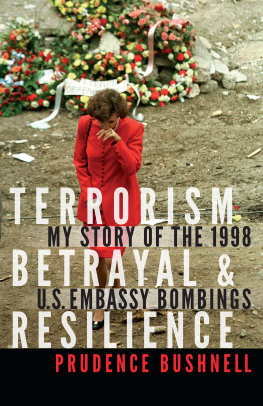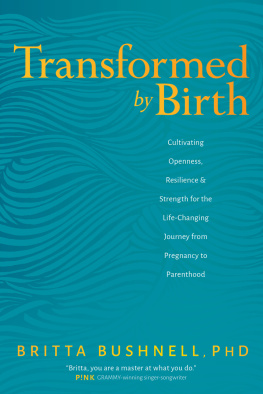A gripping diplomatic thriller that tells the harrowing saga of the 1998 bombing of Embassy Nairobi. Ambassador Bushnells first-person account provides lessons of leadership, crisis management, and policy acumen. The tale dramatically illustrates the terrorism danger diplomats confront daily.
Ambassador Robert E. Gribbin III (Ret.)
Ambassador Prudence Bushnell is a true professional with the toughness, grit, courage, and compassion that marks the kind of superb leader you want in charge during a crisis. I witnessed her remarkable composure, even when personally injured, and her take-command leadership style. This book is important for many reasons. It vividly presents a profile in courage; an understanding rarely appreciated about our foreign service men and women working in difficult assignments; a set of valuable lessons learned; and a case study in leadership during crisis. Every American should read this book.
Gen. Anthony C. Zinni, U.S. Marine Corps (Ret.)
With heroes and villains aplenty, this riveting cold tale of the 1998 bombing of the U.S. embassy in Kenya has startling relevance. As todays State Department struggles to survive a gutting by its own government, Prudence Bushnell reminds us just how important and dangerous the job of diplomacy can be.
Rheta Grimsley Johnson, syndicated columnist and author of Poor Mans Provence: Finding Myself in Cajun Louisiana
Terrorism, Betrayal, and Resilience
ADST-DACOR Diplomats and Diplomacy Series
Series Editor: Margery Boichel Thompson
Since 1776, extraordinary men and women have represented the United States abroad under widely varying circumstances. What they did and how and why they did it remain little known to their compatriots. In 1995 the Association for Diplomatic Studies and Training ( ADST ) and DACOR , an organization of foreign affairs professionals, created the Diplomats and Diplomacy book series to increase public knowledge and appreciation of the professionalism of American diplomats and their involvement in world history. The disturbing aftermath of the August 1998 bombings of Embassy/Nairobi and Embassy/Dar es Salaam forms the dramatic core of Ambassador Prudence Bushnells tale of terror and resilience. It is the sixty-fifth volume in the series.
Terrorism, Betrayal, and Resilience
My Story of the 1998 U.S. Embassy Bombings
Prudence Bushnell
An ADST-DACOR Diplomats and Diplomacy book
Potomac Books
An imprint of the University of Nebraska Press
2018 by Prudence Bushnell
Part of chapter 12 was originally published in Foreign Service Journal (JanuaryFebruary 2017).
The views and opinions in this book are solely those of the author and do not necessarily reflect those of the Association of Diplomatic Studies and Training, DACOR , Inc., or the Government of the United States.
Cover designed by University of Nebraska Press; cover image AP Images / John McConnico.
Author photo Tony Awad, Photo Scope Studios.
All rights reserved. Potomac Books is an imprint of the University of Nebraska Press.
Library of Congress Cataloging-in-Publication Data
Names: Bushnell, Prudence, 1946, author.
Title: Terrorism, betrayal, and resilience: my story of the 1998 U.S. Embassy bombings / Prudence Bushnell.
Other titles: ADST-DACOR diplomats and diplomacy series.
Description: Lincoln: University of Nebraska Press, 2018. | Series: ADST-DACOR diplomats and diplomacy series | Includes bibliographical references and index.
Identifiers: LCCN 2018008993
ISBN 9781640121010 (cloth: alk. paper)
ISBN 9781640121324 (epub)
ISBN 9781640121331 (mobi)
ISBN 9781640121348 (pdf)
Subjects: LCSH : United States Embassy Bombing, Nairobi, Kenya, 1998. | Jihad. | Women ambassadorsUnited StatesBiography. | AmbassadorsUnited StatesBiography. | Leadership. | Leadership in women. | TerrorismPrevention.
Classification: LCC HV 6433. K 4 B 87 2018 | DDC 363.325096762509049dc23 LC record available at https://lccn.loc.gov/2018008993
The publisher does not have any control over and does not assume any responsibility for author or third-party websites or their content.
This book is dedicated to the people whose lives were lost on August 7, 1998, in Nairobi, Kenya, and Dar es Salaam, Tanzania
Contents
This is an account of the war on terror and my life. The book begins with the al-Qaeda attacks on the U.S. embassies in Kenya and Tanzania on August 7, 1998, and ends in the fall of 2017. This is my personal perspective.
Most books about al-Qaeda and the war on terrorism highlight the perpetrators. This one starts with the story of survivors and how we found resilience as a Kenyan and American community. Most books about al-Qaeda and the war on terrorism are written by men; I am a woman. Most books about the war on terrorism focus on tactics; I focus on leadership.
I cannot separate the story of August 7what happened and howfrom my own because we were both products of foreign policies made in Washington with little thought of long-term impacts, much less of the people implementing them overseas. I grew up in a Foreign Service family among the ruins of World War II in Germany and France and the consequences of the Cold War in Pakistan and Iran. When I returned for college in the United States in the mid-1960s, policy discussions about race and war were taking place in the streets, and I had to figure out where I fit into this country of mine. In the 1970s policies and attitudes about women made me a feminist, and a court-imposed affirmative action program in the Department of State brought me into the Foreign Service in my own right in the early 1980s.
In 1998, when the bombs went off in Kenya and Tanzania, Congress was in recess. The White House, along with the entire country, was focused on the Monica Lewinsky scandal and efforts to impeach President Bill Clinton. Congress held no hearings about the bombings, the national security community held no after-action reviews, and the mandatory Accountability Review Board focused on narrow security issues. Then on September 11, 2001, al-Qaeda attacked the U.S. homeland and the East Africa bombings became little more than a footnote.
Investigations into the 9/11 attacks revealed just how much parts of our law enforcement and intelligence communities had known about al-Qaeda since 1996, two years before we were blown up in Nairobi and Dar es Salaam. I wanted to know how these bombings could have happened, given the scrutiny bin Laden and his cell in Nairobi were getting from special groups in the National Security Council, the FBI, the CIA , and the NSA .
I also wanted to tell the story of our community and what it was like to work in an embassy struggling toward normalcy after a life-changing attack. For all of the treasure and lives consumed by the war on terror, the targets and survivors receive little attention. As terrorist threats and our conflicts with jihadists continue through a fourth presidency, I highlight lessons that prevented our government from safeguarding its diplomatic facilities in contrast to our communitys resilience and leadership that enabled good people to prevail. We can be wounded, angry, happy, sorry, sad, scared, and hopeful and still carry on.
I tell the story in three parts. Part 1 is a personal chronicle of the bombing and its aftermath that includes a narrative of my own life. I move back in time to share what it was like beginning life as a third culture kid in the Foreign Service and moving through patriarchal cultures and the State Department hierarchy to become an ambassador. As a girl growing up in the 1950s, it was inconceivable that I could become a leader, much less one who excelled in disasters. My only role model was Joan of Arc, and I was well aware of what happened to her when she put on a pair of pants and led men. But I did become a leader, intentionally, and the bombing in Nairobi was a test of leadership the likes of which I never imagined. More important to the nation, it was the act of a war in which the United States had no idea it was engaged.














